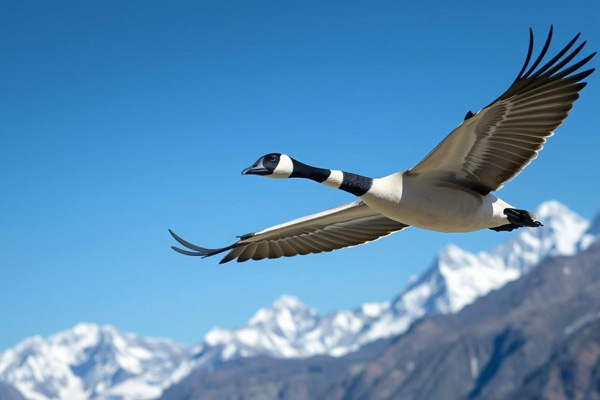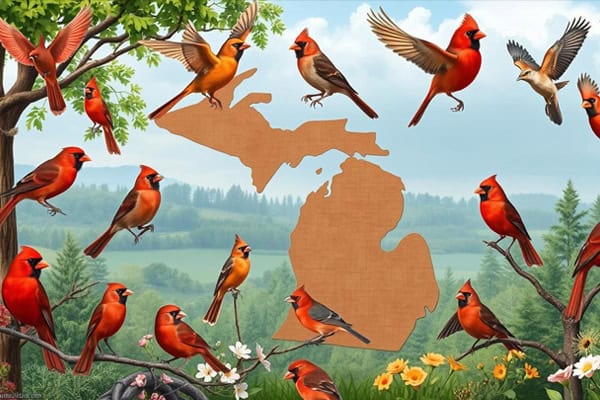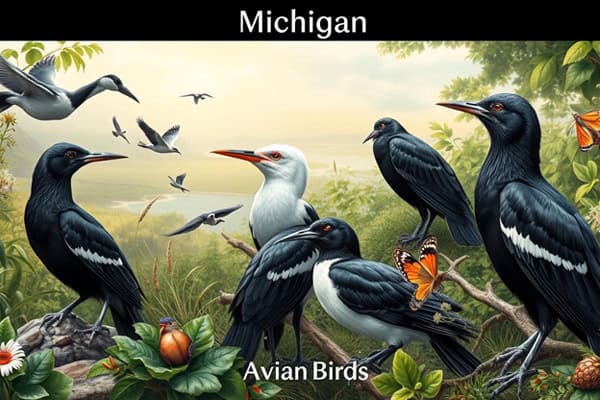Bar-Headed Goose: High-Flying Himalayan Marvel
Did you know the Bar-Headed Goose can fly up to 7,000 meters high? It’s one of the highest-flying birds in the world. These Himalayan birds fly through the dangerous mountain ranges of the Himalayas every year.
It is amazing how they can survive in extreme conditions during migration. The Bar-headed Goose has a wingspan of 140 to 160 cm. Its special adaptations help it live in places where most animals can’t.
This article will explore the Bar-Headed Goose’s world. We’ll examine its physical traits, migration, diet, and how it adapts to high altitudes. We’ll also talk about its breeding habits and conservation status. Get ready to learn about this incredible bird as it soars through the skies!
Introduction to the Bar-Headed Goose
The Bar-Headed Goose is a fascinating bird known for flying high over the Himalayas. They are about 75 cm (30 inches) long and weigh between 1.87 to 3 kg (4 to 6.5 lbs). These geese migrate from November to December, heading to India.
In India, they like to stay near water in places like Mysuru, Mandya, and Chamarajanagar. This shows how adaptable they are.
These geese take unusual paths due to environmental changes. This is why we need to protect them. Events like World Migratory Bird Day help us understand their journeys.
There are at least 10,000 Bar-Headed Geese in the world, and they are not in danger. But, their numbers are going down. This is why we must keep working to save them.
By helping with bird conservation, you can help these amazing birds. This way, they can keep flying for many years to come.
| Statistical Data | Details |
|---|---|
| Size | 75 cm (30 in) |
| Weight | 1.87 to 3 kg (4 to 6.5 lbs) |
| Incubation Period | 27 days |
| Clutch Size | 4 to 6 eggs |
| Fledging Duration | 50 days |
| Sexual Maturity | 3 years |
| Habitat Range | Countries include Afghanistan, China, India, Nepal, Russia |
| Global Population | At least 10,000 mature individuals |
| Conservation Status | Least Concern (IUCN) |
Physical Characteristics of the Bar-Headed Goose
The Bar-Headed Goose has amazing physical traits that help it live well. Knowing these traits is key for spotting waterfowl. Its unique look and size make it easy to recognize.
Distinctive Features
The Bar-Headed Goose looks striking. It has white and grey feathers with black lines on its head and neck. Its orange-yellow bill and legs add to its beauty. Spotting these features helps identify waterfowl.
Wingspan and Size
The Bar-Headed Goose is about 75 cm (30 in) long and weighs 1.87 to 3 kg (4 to 6.5 lbs). Its wingspan is 140 to 160 cm, making it look great in the sky. Males are a bit bigger than females but they look very similar. Their special body helps them fly long distances.
Migration Patterns of the Bar-Headed Goose
The Bar-Headed Goose migration is truly amazing. In winter, they travel long distances to find good places to live. They like freshwater lakes, rivers, and fields with lots of food.
Understanding their migration shows how well they adapt to their journey. It’s a remarkable sight to see.
Wintering Habitats
In winter, Bar-Headed Geese live in places with lots of water in India and nearby. They need these areas for food and to stay warm. But, climate change might change where they live, affecting their numbers.
Route over the Himalayas
The Bar-Headed Goose flies over the Himalayas, the highest mountains. They fly up to 7,000 meters high. This shows their strong bodies and will to survive.
They take different paths, sometimes flying together and sometimes apart. This shows their great sense of direction and how they find the best places to live and breed.
Scientific Marvel of Migration
Scientists study the Bar-Headed Goose migration to learn more. They found that different groups of geese migrate in different ways. Geese from Mongolia are bigger than those from China, showing they adapt to their homes.
This research helps us understand how these birds deal with changes in their environment. It’s important for their survival.
| Parameter | Mongolia | China | Overall Findings |
|---|---|---|---|
| Geese Studied | 23 | 29 | 60 |
| Wintering Areas | Southern Tibetan-Qinghai Plateau | Near Lhasa | Increased congregations |
| Migration Behavior | Leap-frog migration pattern | Standard migration | Divergent migration corridors |
| Moulting Locations | Various lakes | Specific lakes identified | Dependent on habitat availability |
Diet and Feeding Habits
The Bar-Headed Goose has interesting ways of eating. It eats grasses, plants, grains, nuts, roots, and tubers. This bird eats a lot of different things, showing it can survive in many places.
Learning how the Bar-Headed Goose finds food helps us understand how it stays alive.
Preferred Foods
Bar-Headed Geese love to eat:
- Highland grasses
- Crops like corn, wheat, barley, and rice
- Seeds, especially in the spring
They often go to the southern Tibetan-Qinghai Plateau in winter. There, about 25% of the world’s geese live. They also eat in fields, affecting local farming.
Foraging Behavior
Bar-Headed Geese forage together. This makes them better at finding food. They often look for food near water.
Even though they mostly eat plants, they sometimes eat small insects or crustaceans. This shows they are very flexible in what they eat.
Adaptations for High Altitude Flight
The Bar-Headed Goose has amazing adaptations for flying high. These help them survive the tough conditions of their migrations. They fly over the Tibetan Plateau at about 4800 meters.
These changes show how incredible this species is.
Physiological Changes
One key adaptation is their high-affinity hemoglobin. This helps them carry oxygen better, even in thin air. They don’t get tired or change much when flying long distances.
This is different from how humans get tired at high elevations.
Oxygen Absorption Mechanisms
Their way of getting oxygen is through more capillaries in their lungs. This lets them breathe better while flying. In tests, they flew long and kept their wingbeats steady, even in low oxygen.
They use oxygen well, showing they’re good at managing energy at different heights.
| Condition | Resting Metabolic Rate (ml O2 min−1 kg−1) | Heart Rate (beats per minute) | CO2 Pulse (ml CO2 beat−1 kg−1) | Flight Duration (seconds) |
|---|---|---|---|---|
| Normoxia | 12.5 ± 0.4 | 126.4 ± 7.4 | 0.085 ± 0.003 | 187.7 ± 20.7 |
| Moderate Hypoxia | Varied | 108.1 ± 4.1 | 0.074 ± 0.003 | 148.9 ± 22.3 |
| Severe Hypoxia | Varied | 149.2 ± 24 | 0.068 ± 0.005 | 79.1 ± 36.6 |
These amazing adaptations let bar-headed geese fly over the world’s highest landscapes. They show the wonders of evolution in high altitude birds.
Reproduction and Breeding Behaviors
The Bar-Headed Goose has interesting ways of reproducing and breeding. They are very loyal to their mates, showing strong monogamous behavior. This means they stay together for life, working as a team to raise their young.
When there are more females than males, some females might join another pair. This shows how complex their social lives can be.
Monogamous Pairing
One key thing about Bar-Headed Geese is their monogamous pair bonds. These bonds last through the breeding season. This helps both parents work together to care for their babies.
This teamwork is important for keeping the babies safe from predators. It helps them survive better.
Nesting and Incubation
When it’s time to nest, Bar-Headed Geese choose places near water. This keeps the eggs safe. Both parents help build the nest, using plants and feathers.
A female lays between three and eight eggs at a time. The eggs incubate for about a month. This lets the babies grow strong enough to hatch.
After hatching, the babies are ready to move around. But they are still very vulnerable. They need to stay safe from predators.
| Breeding Aspect | Description |
|---|---|
| Pair Bonding | Monogamous relationships typically last for the breeding season. |
| Nesting Location | Nests are built near water sources with both parents participating. |
| Egg Clutch Size | Between 3 to 8 eggs are laid in a single nest. |
| Incubation Period | Approximately 30 days before hatching occurs. |
| Gosling Development | Precocial young can leave the nest soon after hatching but are prone to predation. |
Conservation Status and Threats
The Bar-Headed Goose is listed as “Least Concern” by the IUCN Red List. Yet, it faces many challenges. Climate change and habitat loss are main reasons for its decline. Knowing these threats is key to saving the goose.
Population Trends
The Bar-Headed Goose population is between 97,000 and 118,000. In south-central Tibet, numbers are growing. Surveys in January 2014 found over 67,000 in the area.
This increase is good news. But, threats still exist.
Threats to Habitats
Habitat loss, pollution, and land use changes harm the Bar-Headed Goose. Wetlands, their homes, are being destroyed. This hurts their migration and wintering spots.
Pesticides and the loss of natural areas also threaten them. These issues make survival harder.
Conservation Efforts
Efforts to save the Bar-Headed Goose are growing. Community help is crucial, especially in places like Gadag, Karnataka. They watch for geese and push for protection.
Together, they work to keep wetlands safe. This is vital for the geese’s future.
Read More🐦Related Articles:
- Woodpeckers in Wisconsin
- Woodpeckers in Texas
- Kingfisher Bird
- Types Of Hawks
- Biblical Meaning Of Dead Birds
- Can Ducks Eat Cucumber Safely
- Two Birds on a Wire Meaning
Conclusion
The Bar-Headed Goose is a symbol of nature’s amazing ability to adapt. It thrives in harsh places like the Himalayas. This bird’s unique looks and migration paths show its key role in keeping nature in balance.
With 97,000 to 118,000 birds in the 1990s, it’s clear they’re strong. They migrate through the seasons, showing their ability to survive.
Bar-Headed Geese are important for nature’s variety and health. Over 30,000 use the Western Tibetan Flyway, and more than 80,000 go to the Eastern one for winter. Their paths show how they interact with their environment.
But, they face many dangers that could harm their travels and homes. This could change their lives forever.
It’s vital to keep these amazing birds alive. We must watch their numbers, learn about their travels, and protect their homes. By doing this, we help the Bar-Headed Goose and our planet.
Protecting this bird helps our world stay healthy. It shows how everything in nature is connected.







